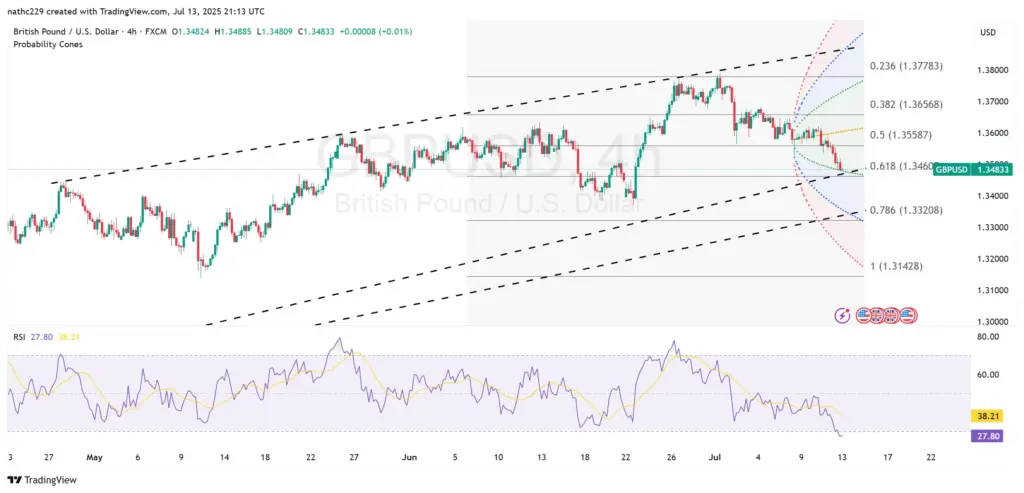GBP/USD Extends Losses as Disappointing UK Data and Tariff Concerns Weigh Heavily

Overview
GBP/USD remains under substantial selling pressure, extending losses amid softening UK economic performance and intensified worries regarding potential inflationary impacts from heightened tariff concerns. With bearish sentiment solidifying, sterling's near-term outlook has become increasingly negative, particularly as it approaches pivotal technical support levels.
Technical Outlook
GBP/USD’s recent decline has brought the currency pair near critical technical support, notably the rising 55-day moving average at 1.3482, closely aligning with the recent low of 1.3481. This area represents a key technical juncture; a confirmed break below could signal significant bearish potential.
Further downside supports include the daily Ichimoku cloud top at 1.3447 and the rising lower boundary of the 30-day Bollinger Band at 1.3409. Should these supports fail to hold, the technical picture would worsen considerably, potentially opening the door for deeper bearish moves towards the June 23 low at 1.3373 and subsequently targeting the major retracement level near 1.3250.
Resistance remains well-defined, with immediate upside capped by Friday's high at 1.3583. The declining 10-day moving average at 1.3629 now serves as a robust barrier, marking a critical resistance zone that must be overcome to restore any meaningful bullish momentum. Further resistance above this level lies at the upper 30-day Bollinger Band at 1.3748.
Momentum indicators continue to trend bearish, with declining RSI reinforcing the negative outlook. Persistent bearish pressure below the 10-day moving average underscores the ongoing bearish sentiment and indicates limited near-term upside potential.
Economic Indicators and Market Drivers
Weak UK GDP and industrial output data have been key drivers behind sterling's recent bearish momentum. These indicators raised substantial concerns regarding the UK's economic trajectory, fueling market speculation of potential Bank of England rate cuts in response to economic slowdown signals.
Upcoming economic data releases will be crucial in shaping short-term market dynamics. Key events include UK retail sales on Monday, U.S. CPI data on Tuesday, and UK CPI data on Wednesday. Each of these data points carries significant implications for rate expectations from both the Bank of England and the Federal Reserve.
The broader monetary policy landscape, as reflected by the latest Interest Rate Probability Rates (IRPR) from LSEG, indicates the Fed and Bank of England maintaining parallel rate paths throughout 2025, with expectations for a dovish shift by the Fed later in 2026. Nevertheless, renewed concerns regarding tariffs and global inflation may enhance the dollar's relative appeal, offsetting any short-term dovish impacts on the dollar.
Risks and Potential Consequences
The immediate risk facing GBP/USD is the continuation of weak UK economic data, solidifying expectations for Bank of England rate cuts. Prolonged economic softness or disappointing data outcomes would exacerbate bearish pressures.
Geopolitical and tariff-related uncertainties also represent significant risk factors. Heightened global trade tensions could stoke inflation concerns, further benefiting the dollar and exacerbating sterling weakness.
Technically, failure to hold above critical support levels at 1.3481 and 1.3447 could accelerate bearish momentum significantly, risking deeper declines towards lower psychological and technical support levels.
Strategic Considerations
Bearish traders should strategically position stop-losses above immediate resistance at 1.3583 and critical resistance at the declining 10-day moving average (1.3629). Confirmation of further bearish momentum below key support levels at 1.3481 would justify maintaining or increasing short positions.
Conversely, bullish traders should await clear technical stabilization signals, particularly sustained moves above the 10-day moving average, before considering new long positions.
Conclusion
GBP/USD remains vulnerable to further downside, driven by soft UK data, rising tariff concerns, and significant technical barriers. Traders should carefully monitor economic indicators and technical developments to navigate potential market volatility effectively.
